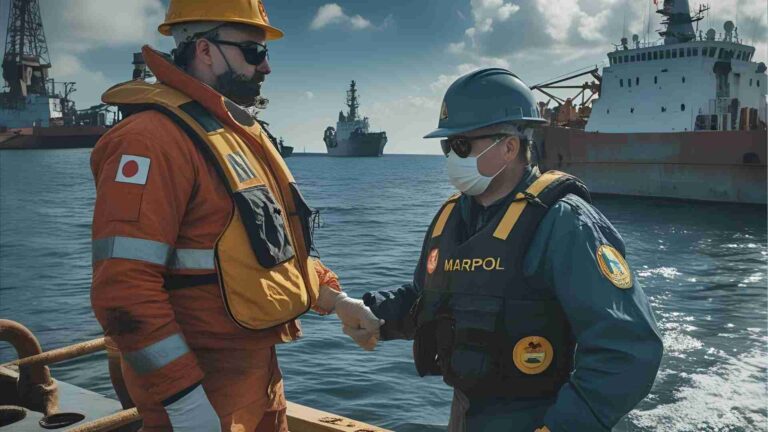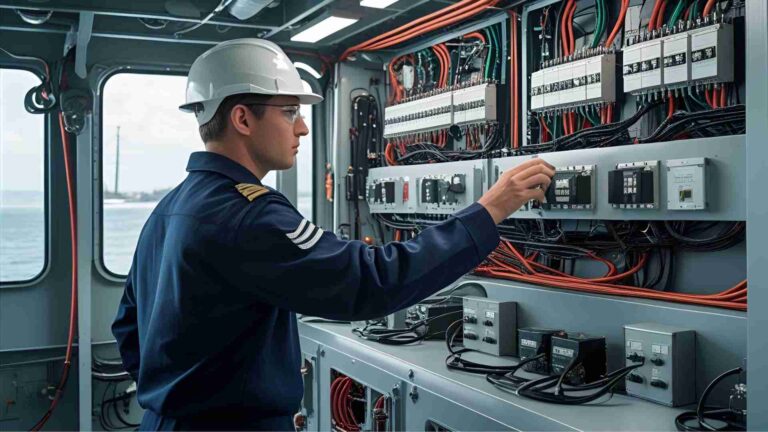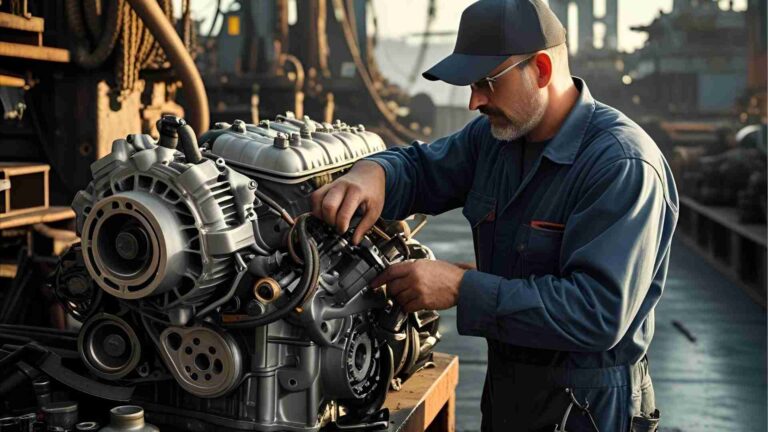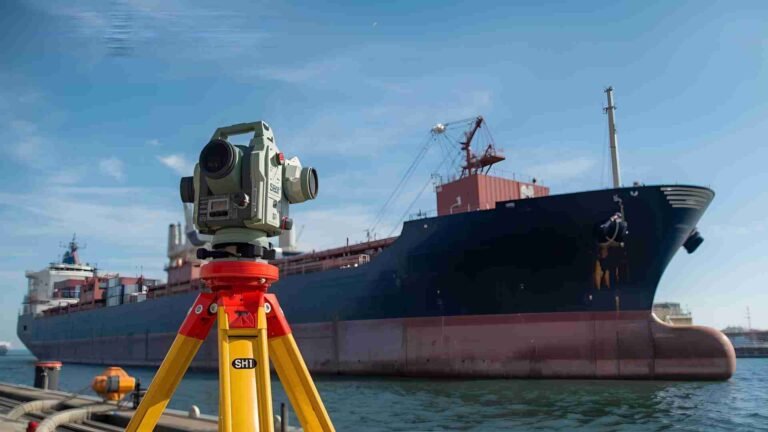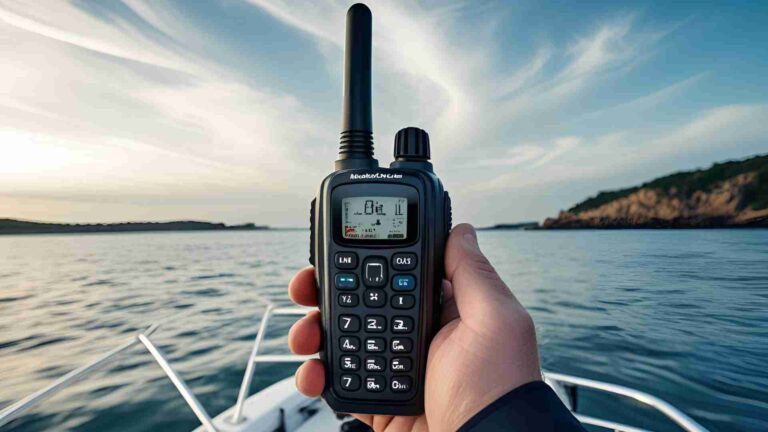What is Onshore Power Supply (OPS)
Discover Onshore Power Supply (OPS): how it reduces ship emissions, enhances sustainability, and meets global regulations. Learn about its benefits, challenges, and adoption trends.
Onshore Power Supply (OPS), also known as shore power, cold ironing, or Alternative Maritime Power (AMP), is a transformative technology enabling ships to connect to a port’s electrical grid while docked, allowing them to shut down their auxiliary engines. This shift significantly reduces emissions, noise pollution, and operational costs, positioning OPS as a cornerstone of sustainable maritime operations. As global environmental regulations tighten and ports strive to meet climate goals, OPS adoption is accelerating, reshaping the maritime industry’s environmental footprint. This article explores the mechanics, benefits, challenges, and global trends of OPS, supported by case studies, data, and actionable insights.
What is Onshore Power Supply?
OPS involves supplying electrical power from a port’s grid to a berthed ship, enabling it to power onboard systems—such as lighting, heating, air conditioning, and cargo handling—without running auxiliary engines. These engines, typically powered by fossil fuels, emit pollutants like nitrogen oxides (NOx), sulfur oxides (SOx), particulate matter (PM), and carbon dioxide (CO2), contributing to poor air quality and greenhouse gas emissions in port areas. By connecting to shore power, ships eliminate these emissions locally, improving environmental conditions for port workers and nearby communities.
How OPS Works
- Connection Process: Ships use a standardized cable and plug system to connect to the port’s electrical grid. The connection typically involves high-voltage systems (6.6kV to 11kV for larger vessels) and requires compatible equipment on both the ship and the shore. Ports provide switchgear, transformers, and frequency converters to align the grid’s electrical characteristics (voltage, frequency) with the ship’s requirements.
- Emission Reduction: OPS eliminates emissions from auxiliary engines during berthing. Studies, including those by the U.S. Environmental Protection Agency, indicate reductions of up to 98% for pollutants like NOx, SOx, and PM, depending on the energy source. When powered by renewable energy, CO2 emissions can drop by over 57%.
- Standardization: The IEC/IEEE 80005 standard governs high-voltage shore connections, ensuring safe and interoperable systems. However, variations in voltage, frequency, and plug placement across vessel types pose challenges to universal adoption.
Benefits of Onshore Power Supply
OPS offers multifaceted advantages, spanning environmental, economic, and operational domains. Below is a detailed breakdown of its benefits.
Environmental Benefits
- Emission Reduction: OPS drastically cuts air pollutants. A study at the Port of Kaohsiung reported an 8.7% reduction in NOx and an 11.74% reduction in SO2 emissions. In the UK, ports using OPS have achieved 25–92% reductions in various pollutants. When renewable energy powers OPS, CO2 emissions can decrease by up to 57.16%.
- Noise Reduction: Shutting down auxiliary engines eliminates engine noise and vibrations, improving the quality of life for port workers and nearby residents.
- Climate Goals: OPS aligns with global decarbonization targets, such as the EU’s Fit for 55 package and the International Maritime Organization’s (IMO) goal of carbon neutrality by 2050.
Economic Benefits
- Fuel and Maintenance Savings: By reducing reliance on fossil fuels, OPS lowers fuel costs and engine wear, decreasing maintenance expenses. For example, the Port of Gothenburg’s OPS system for RoRo vessels reduced costs due to lower power requirements and existing high-voltage infrastructure.
- Market Competitiveness: Ports with OPS attract eco-conscious shipping companies, enhancing their reputation and business prospects. Shipowners adopting OPS can leverage sustainability credentials to meet customer and regulatory demands.
- Public Funding: Government incentives, such as EU grants under the Alternative Fuels Infrastructure Regulation (AFIR), offset high initial costs, making OPS financially viable.
Operational Benefits
- Grid Stability: OPS can stabilize local grids by providing frequency control and ancillary services, particularly when integrated with renewable energy sources like solar or wind.
- Compliance: OPS ensures compliance with stringent regulations, such as the FuelEU Maritime Regulation, effective January 1, 2025, which mandates OPS use for container and passenger vessels in EU ports by 2030.
- Improved Working Conditions: Reduced noise and emissions create a healthier environment for seafarers and port workers.
Challenges of Implementing OPS
Despite its benefits, OPS adoption faces significant hurdles, requiring coordinated efforts from ports, shipowners, and regulators.
Financial Barriers
- High Initial Costs: Installing OPS infrastructure is expensive, with costs ranging from €1 million to €25 million per berth, depending on power demands and grid upgrades. For example, the Port of Rotterdam estimated €4 million per berth, while Gothenburg’s costs were lower at €225,000 for two berths due to existing infrastructure.
- Ship Retrofitting: Equipping vessels for OPS can cost $300,000 to $2 million per ship, depending on size and transformer needs. These costs deter smaller operators.
- Revenue Uncertainty: Unpredictable electricity sales and grid access create financial risks for ports and shipowners.
Technological and Infrastructure Challenges
- Grid Capacity: Many ports lack the grid capacity to support high-power demands, especially for large vessels like cruise ships (up to 16MW) or container ships (up to 7.5MW). Upgrading local grids requires significant investment and coordination with utility providers.
- Vessel Compatibility: Not all ships are OPS-ready, necessitating costly retrofits or newbuilds designed with OPS compatibility.
- Standardization Issues: Variations in voltage (e.g., 6.6kV vs. 11kV), frequency (50Hz vs. 60Hz), and plug placement hinder interoperability. The Port of Oakland and Port of Long Beach, for instance, use different OPS solutions due to safety and technical differences.
Regulatory and Social Challenges
- Regulatory Fragmentation: Inconsistent global standards complicate OPS adoption. While the EU’s FuelEU Maritime and AFIR regulations mandate OPS, other regions lack similar frameworks, leading to uneven implementation.
- Community Engagement: Local resistance to infrastructure projects, particularly in urban ports, can delay OPS deployment. Engaging communities early is critical to gaining support.
- Data Gaps: Limited data on vessel power consumption and grid reliability hinders effective planning and investment decisions.
Global Trends and Regulatory Drivers
OPS adoption is gaining momentum, driven by environmental concerns and regulatory mandates. Below are key trends and regulations shaping its growth.
Growing Adoption
- Port Investments: Ports like Hamburg, Gothenburg, Seattle, and Los Angeles are leading OPS implementation. Hamburg pioneered OPS for cruise ships in Europe, while Gothenburg’s Green Cable system serves tankers with renewable energy.
- Cruise Industry Commitment: The Cruise Lines International Association (CLIA) reports that 120 cruise ships are currently OPS-equipped, with 239 (nearly 80% of the fleet) expected to be ready by 2028. By 2035, CLIA aims for all member ships to use OPS or alternative low-carbon technologies in compatible ports.
- Memorandum of Understanding (MoU): In June 2021, European ports like Antwerp, Bremerhaven, Hamburg, Haropa, and Rotterdam signed an MoU to deploy OPS for container ships by 2028.
Key Regulations
- FuelEU Maritime Regulation: Effective January 1, 2025, this EU regulation mandates OPS or zero-emission technologies for container and passenger vessels by 2030, aiming to reduce fuel emissions intensity.
- Alternative Fuels Infrastructure Regulation (AFIR): AFIR supports OPS infrastructure development in EU Trans-European Transport Network (TEN-T) ports, ensuring renewable energy integration.
- California Air Resources Board (CARB): Since 2007, CARB has required vessels in California ports to use OPS or limit engine use during 80% of port visits, driving adoption in ports like Los Angeles and Long Beach.
- Renewable Energy Directive Old Directive (RED): RED targets 42.5% renewable energy in the EU grid by 2030, complementing FuelEU by ensuring OPS uses sustainable energy sources.
Chart: OPS Adoption Timeline
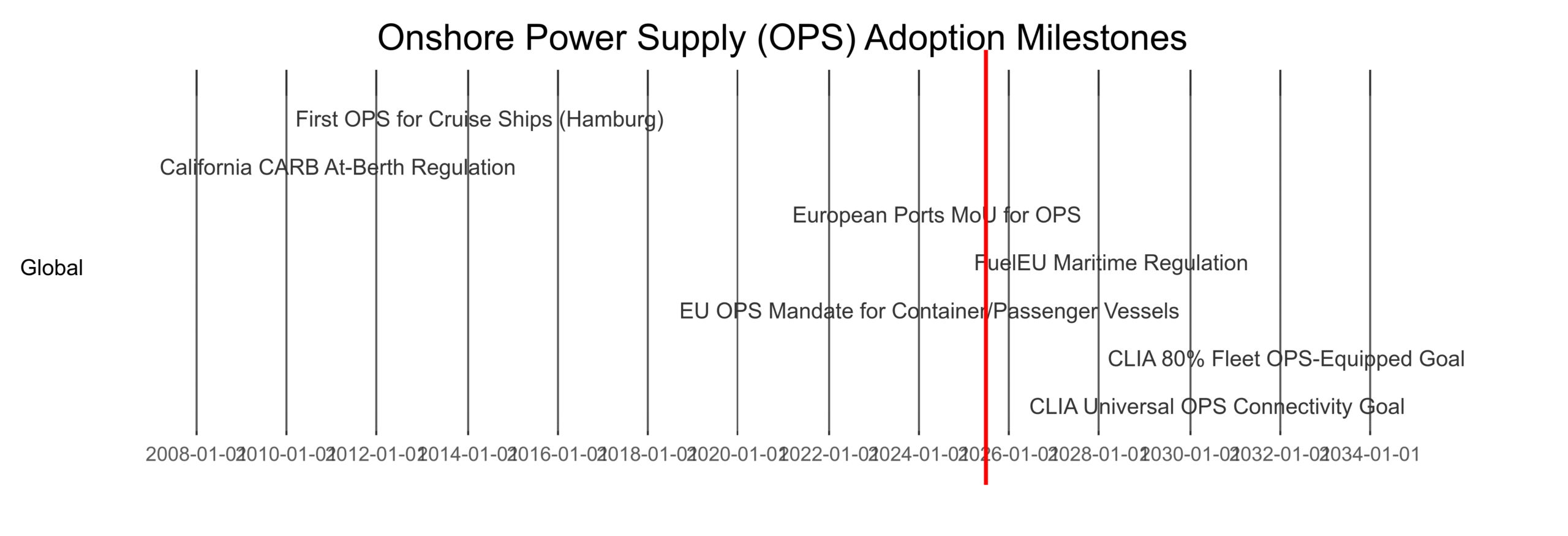
Case Studies: Leading Ports in OPS Implementation
Port of Gothenburg
- Initiative: Introduced the Green Cable system, a unique OPS solution for tankers using renewable energy.
- Impact: Achieved significant cost savings (€225,000 for two berths) due to existing high-voltage infrastructure and low power demands of RoRo vessels.
- Key Insight: Pre-installation vessel cataloging ensures compatibility and cost-effectiveness.
Port of Cádiz
- Partnership: Collaborated with Endesa X to provide 100% renewable shore power, reducing NOx by 96%, SOx by 8%, PM by 94%, and CO2 by 64%.
- Significance: One of Spain’s first ports to offer OPS for cruise ships, aligning with national decarbonization goals.
Port of Bergen
- Progress: Expanded from one OPS system in 2015 to eight systems with 21 supply pits by December 2023, powered by renewable sources via Plug (Eviny).
- Success Factor: Comprehensive vessel data collection ensured tailored infrastructure, boosting adoption.
U.S. Ports (Los Angeles, Long Beach, Seattle)
- Regulatory Driver: CARB’s At-Berth Regulation has spurred OPS adoption, with ten ports operating high-voltage systems and others using low-voltage for smaller vessels.
- Challenges: Infrastructure gaps and vessel retrofitting costs remain barriers, addressed through stakeholder collaboration.
Technical Specifications and Costs
Power Requirements by Vessel Type
| Vessel Type | Voltage | Power Demand |
|---|---|---|
| Cruise Ship (Small) | 6.6kV/11kV | 3–4 MW |
| Cruise Ship (Large) | 6.6kV/11kV | Up to 16 MW |
| Container Ship (Small) | 6.6kV | 1.5 MW |
| Container Ship (Large) | 6.6kV | Up to 7.5 MW |
| Ferry | 6.6kV | 2–4 MW |
Cost Estimates
| Component | Cost Range |
|---|---|
| Port OPS Infrastructure | €1M–€25M per berth |
| Ship Retrofitting | $300,000–$2M per vessel |
| Electricity Transport | $300,000–$4M per berth |
Opportunities and Recommendations
Opportunities
- Environmental Impact: OPS is a proven solution for reducing emissions and noise, supporting ports’ and shipowners’ sustainability goals.
- Regulatory Compliance: Early adoption ensures compliance with regulations like FuelEU and CARB, avoiding fines and enhancing market positioning.
- Long-Term Savings: Reduced fuel and maintenance costs offer a strong return on investment over time.
Recommendations
- Standardization: Develop global standards for voltage, frequency, and plug placement to ensure interoperability.
- Public Funding: Leverage government grants and incentives to offset high capital costs.
- Renewable Energy Integration: Prioritize renewable sources (e.g., wind, solar) to maximize environmental benefits.
- Stakeholder Collaboration: Engage port authorities, shipowners, and utility providers early to align infrastructure with vessel needs.
- Data-Driven Planning: Collect detailed vessel power consumption data to optimize infrastructure investments.
Conclusion
Onshore Power Supply is a pivotal technology in the maritime industry’s journey toward sustainability. By enabling ships to shut down auxiliary engines and connect to shore power, OPS delivers substantial environmental, economic, and regulatory benefits. While challenges like high costs, grid capacity, and standardization persist, global adoption is accelerating, driven by regulations like FuelEU Maritime and CARB, as well as industry commitments from organizations like CLIA. Ports like Gothenburg, Cádiz, and Bergen demonstrate the feasibility and impact of OPS when supported by renewable energy and strategic planning. As the industry navigates financial and technical hurdles, early adopters stand to gain competitive advantages, ensuring compliance and long-term cost savings. With continued investment and collaboration, OPS will play a critical role in achieving a carbon-neutral maritime sector by 2050.
Happy Boating!
Share What is Onshore Power Supply (OPS) with your friends and leave a comment below with your thoughts.
Read What Are MARPOL Special Areas? until we meet in the next article.


